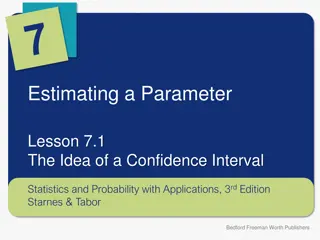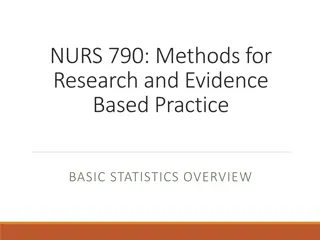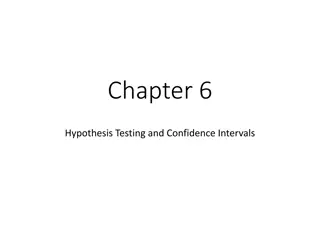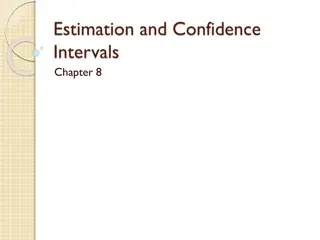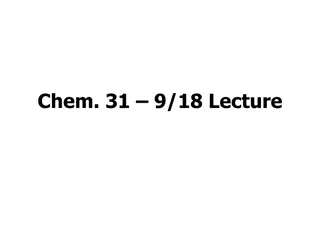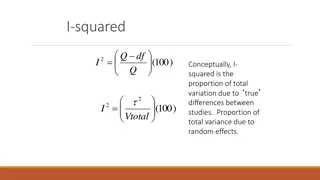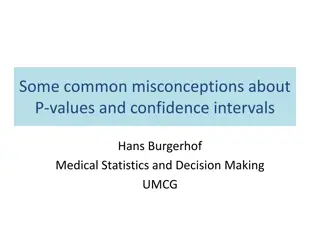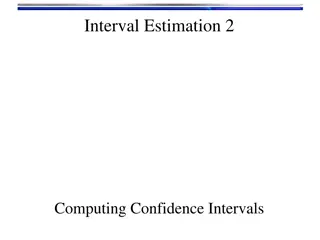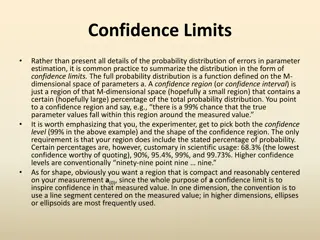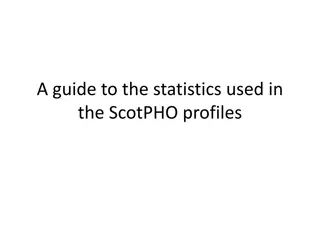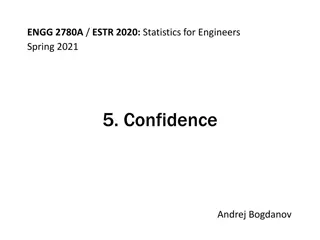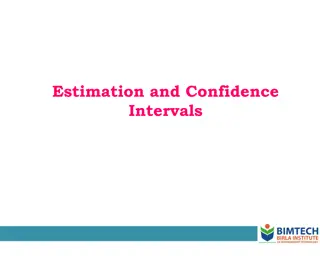Exploring P-Values and Confidence Intervals in Statistics
Many journals require confidence intervals, yet textbooks mainly discuss P-values in relation to null hypotheses, leading to misunderstanding of tests, underappreciation of estimation, and obscuring their close relationship and weaknesses. The history of p-value computations dates back to the 1700s, initially observed by John Arbuthnot and further developed by statisticians like Karl Pearson and Ronald Fisher. The use of P-values in statistical significance evolved over time, with the significance level set at p = 0.05 by Fisher. Despite the prevalent use of P-values in reporting statistical significance with star indicators, subjective interpretations could impact the assessment of evidence against null hypotheses. This exclusive focus on null hypotheses overlooks the complementary nature of P-values and confidence intervals in statistical analysis.
Download Presentation

Please find below an Image/Link to download the presentation.
The content on the website is provided AS IS for your information and personal use only. It may not be sold, licensed, or shared on other websites without obtaining consent from the author.If you encounter any issues during the download, it is possible that the publisher has removed the file from their server.
You are allowed to download the files provided on this website for personal or commercial use, subject to the condition that they are used lawfully. All files are the property of their respective owners.
The content on the website is provided AS IS for your information and personal use only. It may not be sold, licensed, or shared on other websites without obtaining consent from the author.
E N D
Presentation Transcript
Many journals require confidence intervals, but most textbooks and studies discuss P values only for the null hypothesis of no effect. This exclusive focus on null hypotheses 1. in testing not only contributes to 2. misunderstanding of tests and under appreciation of estimation 3. but also obscures the close relationship between P values and confidence intervals, 4. as well as the weaknesses they share.
Computations of p-values date back to the 1700s Where they were computed for the human sex ratio at birth, and used to compute statistical significance compared to the null hypothesis of equal probability of male and female births. John Arbuthnot studied this question in 1710 examined birth records in London for each of the 82 years from 1629 to 1710. John Arbuthnot (1710). "An argument for Divine Providence, taken from the constant regularity observed in the births of both sexes" (PDF). Philosophical Transactions of the Royal Society of London. 27 (325 336): 186 190. doi:10.1098/rstl.1710.0011. Stigler, Stephen M. (1986). The History of Statistics: The Measurement of Uncertainty Before 1900. Harvard University Press. pp. 225 226. ISBN 978-0-67440341-3.
In the 1770s , Pierre-Simon Laplace, instead used a parametric test, He concluded by calculation of a p-value that the excess was a real, but unexplained, effect. The p-value was first formally introduced by Karl Pearson, in his Pearson's chi-squared test, using the chi-squared distribution and notated as capital P. The p-values for the chi-squared distribution (for various values of 2 and degrees of freedom), now notated as P, was calculated in (Elderton,1902), collected in (Pearson 1914, pp. xxxi xxxiii, 26 28, Table XII). The use of the p-value in statistics was popularized by Ronald Fisher, and it plays a central role in his approach to the subject. In his influential book Statistical Methods for Research Workers (1925), Fisher proposed the level p = 0.05, or a 1 in 20 chance of being exceeded by chance, as a limit for statistical significance, and applied this to a normal distribution (as a two-tailed test), thus yielding the rule of two standard deviations (on a normal distribution) for statistical significance (see 68 95 99.7 rule)
Through the 1960s it was a standard practice in many fields to report P values with the star attached to indicate: one star to indicate P < 0.05 and two stars to indicate P < 0.01. Occasionally three stars were used to indicate P < 0.001. While Fisher developed this practice of quantifying the strength of evidence against null hypothesis some eminent statisticians where not accustomed to the subjective interpretation inherent in the method
If the level demanded for significant is 0.05 or lower and the P value that emerge is 0.06, the investigator may be ready to discard a well-designed, excellently conducted, thoughtfully analyzed, and scientifically important experiment because it failed to cross the Procrustean boundary demanded for statistical approbation.
This confusion, perpetuated by medical journals, textbooks of statistics, reviewers and editors, have almost made it impossible for research report to be published without statements or notations such as, statistically significant or statistically insignificant or P<0.05 or P>0.05 . can we get rid of P-values? . the answer : practical experience says no-why?
Italicisation, capitalisation and hyphenation of the term varies. For example 1. AMA (American medical association) style uses "P value" 2. APA (American psychological association) style uses "p value >>> academic documents .. Journals 3. American Statistical Association uses "p-value"
All hypothesis tests ultimately use a p-value to weigh the strength of the evidence (what the data are telling you about the population). The p-value is a number between 0 and 1 and interpreted in the following way: 1. A small p-value (typically 0.05) indicates strong evidence against the null hypothesis, so you reject the null hypothesis. 2. A large p-value (> 0.05) indicates weak evidence against the null hypothesis, so you fail to reject the null hypothesis. 3. p-values very close to the cutoff (0.05) are considered to be marginal (could go either way). Always report the p-value so your readers can draw their own conclusions.
Examples P-value = 0.250 In this case, fully 25% of all possible test statistic values are at least as contradictory to H0 as the one that came out of our sample. So our data is not all that contradictory to the null hypothesis. P-value = 0.0018 Here, only 0.18% (much less than 1%) of all possible test statistic values are at least as contradictory to H0 as what we obtained. Thus the sample appears to be highly contradictory to the null hypothesis.
Q. A significant test result (P 0.05) means that the test hypothesis is false or should be rejected? A. No! A small P value simply flags the data as being unusual if all the assumptions used to compute it (including the test hypothesis) were correct; it may be small because there was a large random error or because some assumption other than the test hypothesis was violated (for example, the assumption that this P value was not selected for presentation because it was below 0.05). P 0.05 only means that a discrepancy from the hypothesis prediction (e.g., no difference between treatment groups) would be as large or larger than that observed no more than 5 % of the time if only chance were creating the discrepancy (as opposed to a violation of the test hypothesis or a mistaken assumption).
Q. A non-significant test result (P > 0.05) means that the test hypothesis is true or should be accepted? A. No! A large P value only suggests that the data are not unusual if all the assumptions used to compute the P value (including the test hypothesis) were correct. The same data would also not be unusual under many other hypotheses. Furthermore, even if the test hypothesis is wrong, the P value may be large because it was inflated by a large random error or because of some other erroneous assumption (for example, the assumption that this P value was not selected for presentation because it was above 0.05). P > 0.05 only means that a discrepancy from the hypothesis prediction (e.g., no difference between treatment groups) would be as large or larger than that observed more than 5 % of the time if only chance were creating the discrepancy.
Q. A large P value is evidence in favor of the test hypothesis? A. No! In fact, any P value less than 1 implies that the test hypothesis is not the hypothesis most compatible with the data, because any other hypothesis with a larger P value would be even more compatible with the data. A P value cannot be said to favor the test hypothesis except in relation to those hypotheses with smaller P values. Furthermore, a large P value often indicates only that the data are incapable of discriminating among many competing hypotheses (as would be seen immediately by examining the range of the confidence interval). For example, many authors will misinterpret P = 0.70 from a test of the null hypothesis as evidence for no effect, when in fact it indicates that, even though the null hypothesis is compatible with the data under the assumptions used to compute the P value, it is not the hypothesis most compatible with the data that honor would belong to a hypothesis with P = 1. But even if P = 1, there will be many other hypotheses that are highly consistent with the data, so that a definitive conclusion of no association cannot be deduced from a P value, no matter how large.
Q. Lack of statistical significance indicates that the effect size is small? A. No! Especially when a study is small, even large effects may be drowned in noise and thus fail to be detected as statistically significant by a statistical test. A large null P value simply flags the data as not being unusual if all the assumptions used to compute it (including the test hypothesis) were correct; but the same data will also not be unusual under many other models and hypotheses besides the null. Again, one must look at the confidence interval to determine whether it includes effect sizes of importance.



